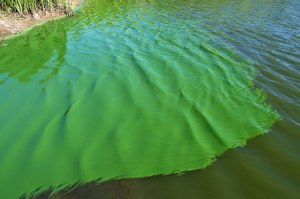Popular Science: Ubiquitous cyanobacteria and how to treat them
Their research was focused on the cyanobacteria Microcystis aeruginosa, which is one of the most common species of cyanobacteria, which occurrs especially in the context of excessive inputs of nutrients. This cyanobacteria is also able to form the so-called algal bloom that has not only damaging environmental impact, but due to the release of a number of toxic substances, the cyanobacteria may additionally seriously threaten human health.
 Fig.: Cyanobacteria cause problems not only during drinking water treatment. Source: Wikimedia Commons, author: Christian Fischer.
Fig.: Cyanobacteria cause problems not only during drinking water treatment. Source: Wikimedia Commons, author: Christian Fischer.
There are also complications during drinking water treatment. Substances produced by cyanobacteria prevent particularly effective coagulation, which otherwise leads to the aggregation of colloidal particles and macromolecular organic compounds into larger units necessary for their further separation. Therefore, scientists have focused on the possibility of increasing coagulation efficiency of the substances produced by cyanobacteria Microcystis aeruginosa, using pre-oxidation potassium permanganate. The pre-oxidation process is usually performed after mechanical pre-treatment and before the next treatment of raw water.
Results of this study demonstrated that the oxidation of organic substances has led to an increase in their removability in other processes of drinking water treatment. The subsequent coagulation with ferric sulphate (Fe2(SO4)3) successfully increases the elimination of peptides and proteins extracted from the cyanobacterium Microcystis aeruginosa. The improvement of organic matter removability using pre-oxidation is primarily because of organic material degradation to inorganic carbon.
Pre-oxidation also shifted the optimum pH range and prevented formation of dissolved organo-metal complexes, which interfere with effective coagulation. However, the authors warn that the oxidant dose must be carefully optimized in order to avoid high residual manganese concentrations in treated water and to maintain the integrity of algae cells in case that they are present in raw water. Nevertheless, there is still a variety of compounds that cannot be either coagulated or degraded by potassium permanganate. It is therefore necessary to use other treatment techniques and still support their further research.
Kateřina Fraindová
Document Actions